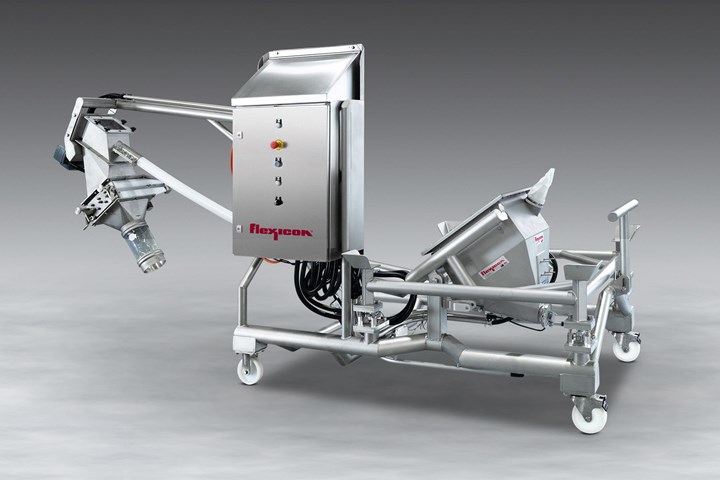Mobile Sanitary IBC Unloading and Conveying System
Transfers contamination-sensitive bulk solid materials from IBCs to downstream processes, dust-free.
Flexicon’s new Mobile Sanitary IBC Unloading and Conveying System transfers contamination-sensitive bulk solid materials from Intermediate Bulk Containers (IBCs) to downstream processes, dust-free.
The discharger frame is mounted on casters for in-plant mobility, while a hinged subframe supporting a surge hopper, flexible screw conveyor and support mast can pivot down for maneuvering through doorways and low-headroom areas.
The IBC frame is forklifted onto receiving cups, which position the IBC outlet onto the surge hopper inlet. Material flowing from the IBC into the charging adapter of a flexible screw conveyor is propelled at an incline, and discharged into elevated process equipment and storage vessels.
The conveyor handles a broad range of free- and non-free-flowing bulk solids ranging from pellets to sub-micron powders with no separation of blended products. The flexible screw is the only moving part contacting material, and is driven by an electric motor positioned beyond the discharge point, preventing material contact with seals.

Ready to plug in and run, the mobile unit can serve multiple functions throughout the plant. It can be rolled to a cleaning station where a lower clean-out cap on the conveyor tube can be removed to flush the smooth interior surfaces with steam, water or cleaning solutions, or to fully remove the flexible screw for cleaning and inspection.
The system is available in carbon steel with durable industrial coating, with stainless steel material contact surfaces, or in all-stainless steel (shown) finished to industrial, food, dairy or pharmaceutical standards.
Related Content
-
Deflection Elbows Eliminate Streamers for Large Film Processor
New elbows eliminate troublesome streamers to increase productivity at leading blown film processor.
-
New Pump Rewrites Conveying Rules
NPE2024: Smart Pump technology brings more flexibility and finesse to resin conveying.
-
Finding Efficiencies in How Components Work Together
Auxiliary systems are vital to the proper functioning of a plastic processing line, and they can be a source of major cost and efficiency improvements.








